Hook: Did you know that unprotected garage floors can lose up to 15% of their lifespan due to winter weather damage? Cold temperatures, melting snow, and road salt can quickly turn your garage floor into a stained and cracked mess. But with the right winter garage floor maintenance, you’ll keep your garage space looking sharp and damage-free, no matter how harsh the season gets.
Winter Garage Floor Maintenance: Why It Matters
"Did you know that unprotected garage floors can lose up to 15% of their lifespan due to winter weather damage?" – National Concrete Institute
Maintaining your garage floor during the winter months is more important than most homeowners realize. The combination of melted snow, dirt and salt, and de-icing chemicals tracked in by vehicles can cause significant and rapid deterioration of garage floors. If left unchecked, even minor issues like small cracks or salt stains can quickly escalate into major structural damage, leading to costly repairs and a decreased lifespan of your investment.
Winter garage floor maintenance is essential to protect your garage floor from the unique challenges brought on by the winter season. By actively removing debris, monitoring for signs of wear, and applying the right floor coatings, you can safeguard the appearance and integrity of your garage floor all winter long. Ultimately, taking preventive measures now will not only preserve your garage space but extend its value and keep your family safe from slips and falls.
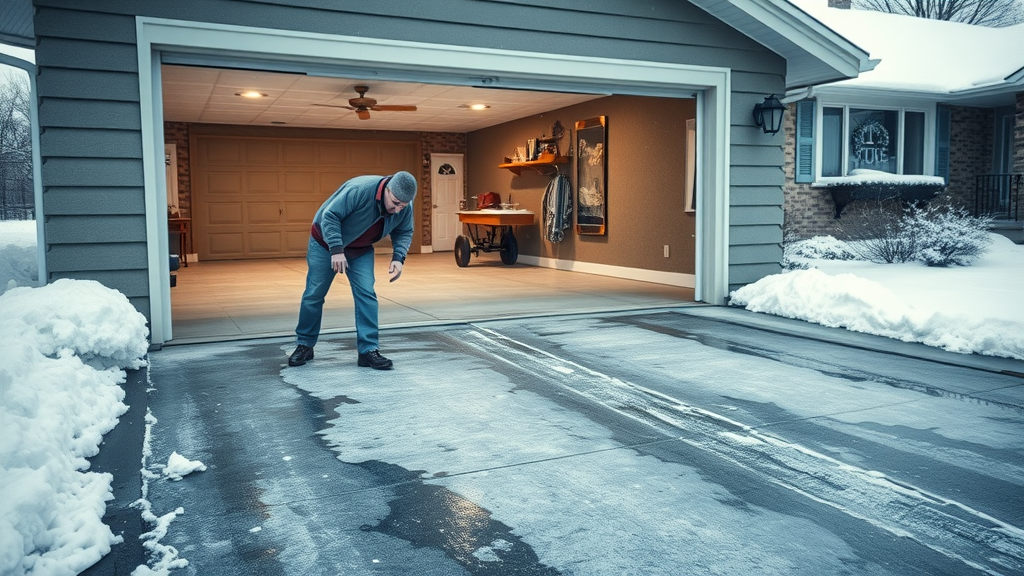
What You’ll Learn in This Guide
- The step-by-step winter garage floor maintenance process
- Best floor coatings to protect your garage
- How to keep your garage floor clean, dry, and damage-free during the winter
- Expert advice to protect your garage floor from salt, moisture, and freezing temperatures
Understanding Common Winter Garage Floor Problems
- Moisture infiltration and freezing
- Salt and chemical damage to garage floors
- Cracks in concrete floors worsening in cold weather
- Stains from snow, slush, and de-icing chemicals on garage floors
- Rust formation and surface erosion
- Uneven surfaces caused by freeze-thaw cycles
During winter, garage floors are exposed to a blend of water, ice, and road salt. These elements can seep into cracks and pores, freeze, and cause the concrete to expand and contract repeatedly—commonly referred to as the freeze-thaw cycle. Over time, this cycle widens cracks and exacerbates existing weaknesses, accelerating floor surface erosion. Salt (and other de-icing chemicals) not only create ugly white stains but actively eat away at the concrete surface, reducing the effectiveness of previous concrete coating and making the floor more susceptible to future damage.
Moisture is a major culprit as it infiltrates unprotected garage floors. When snow, slush, and dirt mix, they form corrosive puddles that, left unattended, allow for rust formation on floor reinforcements and surface erosion. Common visible problems you might spot during the winter months are peeling coatings, discoloration, pitting, rough textures, or sections where melted snow pools or refreezes. Addressing these issues promptly as part of regular winter garage floor maintenance is crucial to avoid expensive restoration and ensure your garage floor remains both safe and visually appealing.
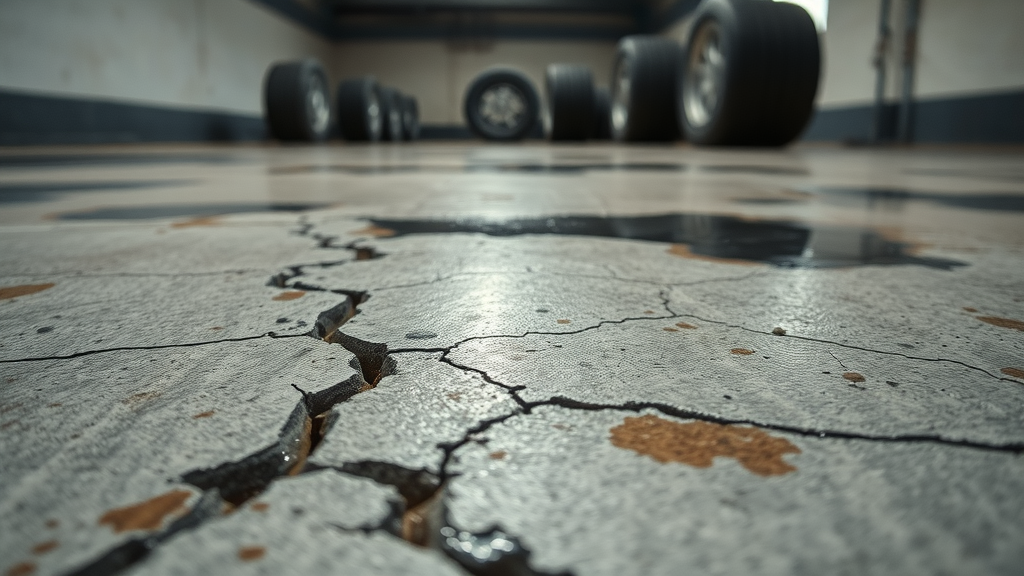
Step-by-Step Winter Garage Floor Maintenance Checklist
- Sweep and wash garage floors regularly
- Remove road salt and de-icers quickly
- Inspect and repair small cracks or chips
- Keep the garage floor dry with mats and proper drainage
- Apply a concrete coating or sealant if needed
A clear winter garage floor maintenance checklist makes it easy to keep your garage floors protected. Start by sweeping up debris and road salt at least twice a week. Salt and dirt left on the surface can grind into the floor, causing small scratches or stains that weaken the epoxy floor or bare concrete. Washing with a mild, non-corrosive cleaner helps remove winter-specific residue, while quickly removing melted snow or water is vital to avoid refreezing issues.
Inspect your garage floor for any new cracks or chips at least every couple weeks. Address these issues with quick-setting concrete patch or crack filler to prevent moisture from worsening them through the winter months. Don’t forget to add absorbent floor mats at entry points—the mats at entry are your first line of defense against excess water, dirt and salt, and potential slips and falls. If your floor coating looks worn, this is the perfect time to reapply a concrete seal or consider upgrading to a more durable coating before winter sets in.
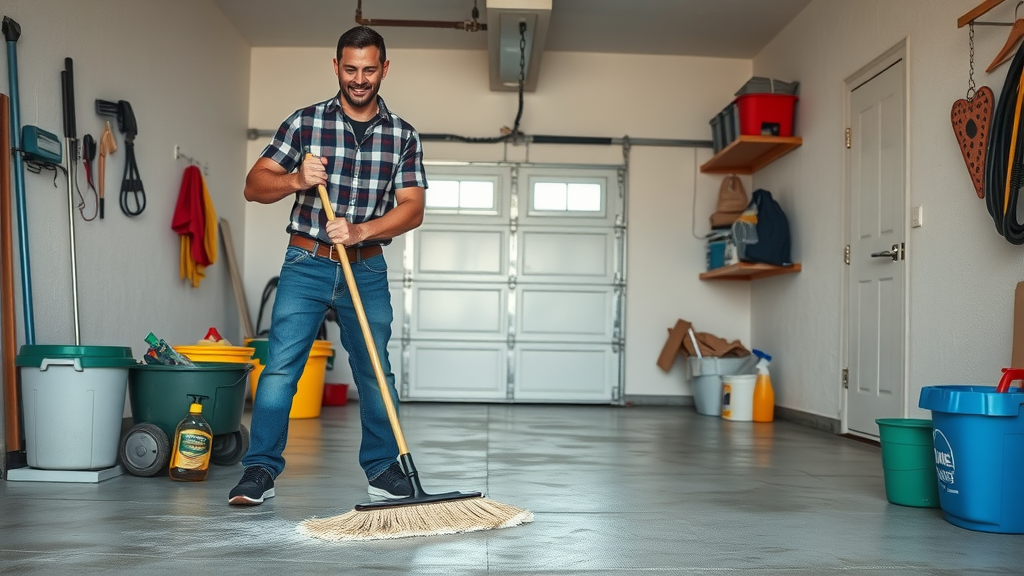
Best Winter Floor Coating Options for Garage Floors
Selecting the right floor coating is one of the best investments to protect your garage floor from damage during winter. Both epoxy coatings and polyaspartic floor coatings act as barriers against moisture and road salt, minimizing the risks of cracks, stains, and surface deterioration. However, each product has its pros and cons when it comes to cold weather performance and application.
A high-quality concrete coating will not only enhance the overall appearance of your garage, but also drastically reduce maintenance throughout the coldest time of the year. Read below for a breakdown of the most effective options and expert comparison based on the latest winter maintenance trends for garage floors.
Epoxy Coatings for Winter Garage Floor Maintenance
Epoxy coatings remain a top choice for homeowners looking to DIY their winter garage floor maintenance. Epoxy forms a hard, durable layer that seals out moisture and blocks salt intrusion, making it excellent for garages in snowy or wet climates. Once cured, epoxy floors resist abrasion from car tires, dropped tools, and regular foot traffic better than bare concrete—effectively extending the life of your garage floor.
However, typical epoxy coatings require careful temperature control during application, as curing times can be significantly longer in low temperatures. For best results, make sure your garage space is heated to at least 50°F and humidity is managed. While application during the depths of winter may be less convenient, epoxy coatings provide long-term, low-maintenance protection. Consider professional installation if you want a near-permanent solution before winter weather peaks.
Polyaspartic Floor Coating vs. Epoxy Coatings: Which is Better in Winter?
Polyaspartic coatings are the gold standard for winter garage floor maintenance—especially if you need a solution that cures quickly and can be applied even in cold weather. These high-build coatings offer enhanced resistance to salt, de-icers, and chemical staining. Unlike epoxy, polyaspartic cures within a few hours, often in temperatures as low as freezing, so you can get your garage floor protected much faster.
While polyaspartic floor coatings come with a higher upfront cost, their superior performance and longevity justify the investment, especially for polyaspartic garage floors and those subject to frequent winter weather. Compare the key differences below to determine which coating fits your winter needs.
| Coating Type | Benefits for Winter | Drawbacks | Durability |
|---|---|---|---|
| Epoxy | Seals against moisture, affordable | Longer cure time in low temps | 10-20 years |
| Polyaspartic | Fast cure, applies in cold, superior salt resistance | Higher upfront cost | 15-25 years |
Concrete Coating Application Tips for Colder Weather
Applying a concrete coating in winter requires some special precaution. First, always check the manufacturer's recommended temperature ranges and opt for formulations labeled for cold-weather epoxy or polyaspartic. Make sure the garage floor is completely clean and dry, as any moisture trapped beneath the coating may cause bubbles, poor adhesion, or early failure.
Pre-warm the space with space heaters if possible and use an industrial fan to increase ventilation and speed up curing times. Avoid applying any floor coating during wet, snowy, or extremely humid days. If possible, monitor overnight temperatures to ensure the product can cure fully without exposure to freezing. For best results, plan to coat your floor during a dry winter spell, with at least 48 hours of stable weather and no moisture.
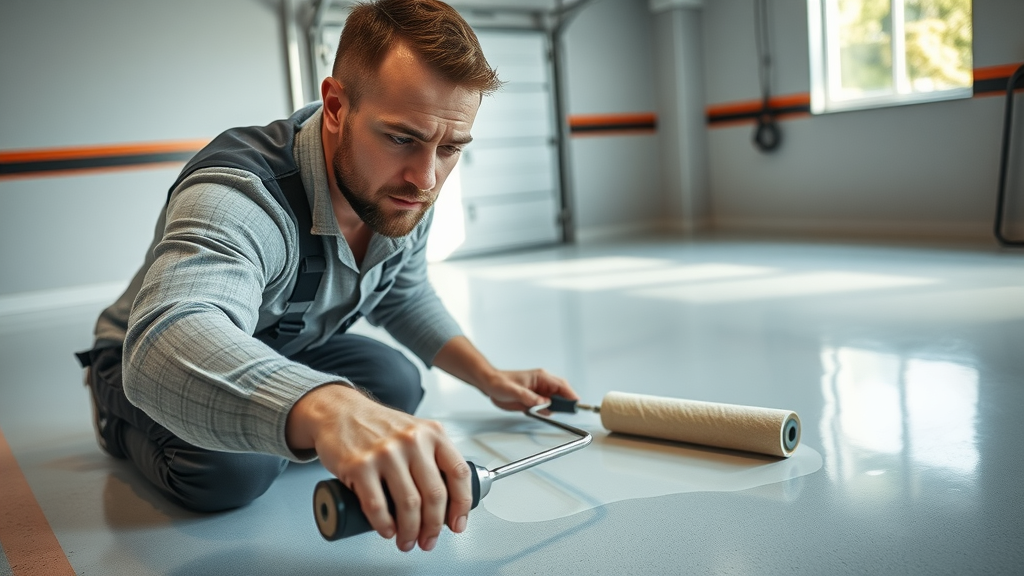
DIY vs. Professional Floor Coatings for Winter Garage Floor Maintenance
"Choosing the right floor coating significantly extends the life of your garage floor while simplifying winter maintenance." – Dr. Jordan Miles, Flooring Specialist
When considering floor coating, weigh the benefits of a professional vs. a DIY approach. While DIY kits (especially epoxy floor options) offer affordability and convenience, expert application ensures perfect adhesion, optimal thickness, and correct curing—even in tricky winter conditions. Professionals can also recommend the right product, whether it’s epoxy or a polyaspartic floor coating, ensuring your garage floor gets the strongest protection possible.
A professional installation may also include warranty coverage and a polished, slip-resistant finish. If you’re on a tight timeline or have previous coating issues, hiring a pro, especially for complex products like polyaspartic garage floor coatings, is the fastest, most reliable path to safeguarding your garage space this winter.
How to Keep Your Garage Floor Clean in the Winter
- Use absorbent garage floor mats
- Install floor squeegees for quick drying
- Opt for non-corrosive cleaners safe for concrete coating
Keeping your garage floor clean during winter is vital for both safety and longevity. As snow and ice melt off vehicles, water in combination with road salt and dirt can quickly create slippery, grimy conditions. The easiest way to prevent build-up is by placing absorbent floor mats at every entry point, especially near the garage door where meltwater pools first. These mats capture excess water, dirt, and salt before they spread across the floor surface.
After big snowfalls, use a floor squeegee or wet/dry vacuum to remove any standing water as soon as possible. Choose cleaners that are specifically formulated for garage floors—not harsh chemicals which might degrade the concrete coating or floor tiles. By prioritizing quick cleanups and targeted cleaning products, you create a safe, clean, and dry environment for your winter garage living needs.
How to Dry Out a Garage Floor in Winter
- Increase airflow with fans or vents
- Use dehumidifiers for persistent moisture
- Install snow-melt mats at entry points
Even if you clean your floor often, winter garage floors may still accumulate dampness. To keep the area permanently dry, increase airflow using wall-mounted fans or by cracking a window (when possible). Dehumidifiers help control moisture if you experience regular condensation or unexplained damp patches on your floor surface—especially common in unheated garage spaces.
Snow-melt mats are another pro tip: they start heating as soon as you drive over them, instantly drying shoes and tires before water spreads. Combined with routine use of floor mats and strategic ventilation, you’ll eliminate slippery spots, lower risks of mold/mildew growth, and preserve the integrity of your winter garage floor maintenance efforts for the long term.
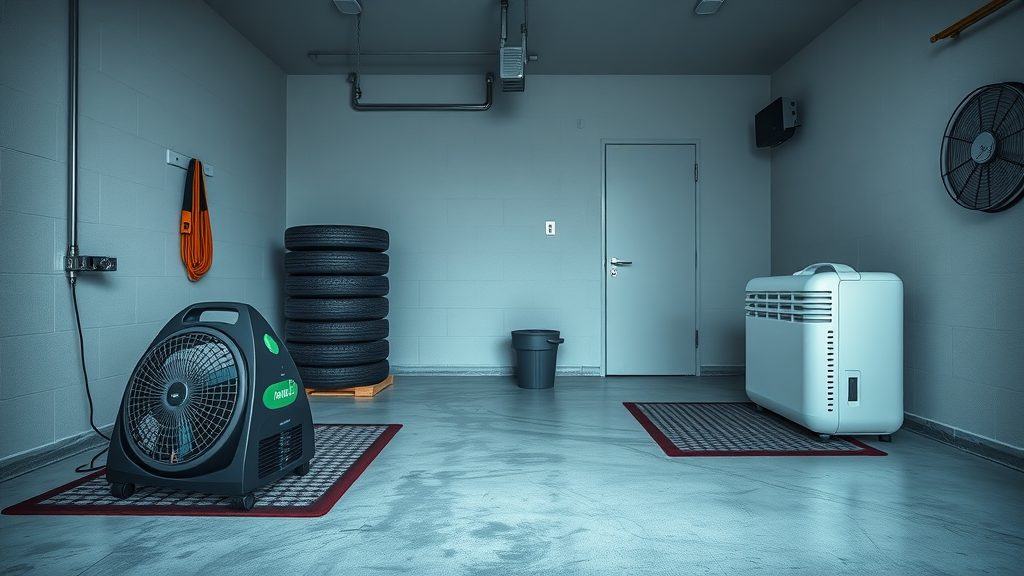
Can You Seal a Garage Floor in the Winter?
- Select polyaspartic or cold-weather epoxies for low temperatures
- Ensure the surface is clean and dry prior to coating
- Plan applications during dry weather spells
Sealing your garage floor in the winter is possible with the right products. Polyaspartic coatings and specially formulated “cold-cure” epoxies can be applied in temperatures as low as 32°F, making them ideal for late-fall or mid-winter projects. Always start with a clean, completely dry floor—trapped moisture can ruin both appearance and longevity.
Monitor weather forecasts for a period of dry, calm days and pre-warm your garage if needed. Avoid applying coatings if freezing conditions are forecasted within 24–48 hours, as rapid temperature drops can halt the curing process or cause surface clouding. By following these steps, you can successfully protect your garage floor throughout winter, even when the weather isn’t ideal.
How to Keep Concrete Garage Floor Warm in Winter
- Apply insulated floor coatings
- Lay thick garage floor mats or tiles
- Use space heaters or overhead radiant heaters
Maintaining a comfortable temperature for your concrete garage floor in winter can help prevent icing, moisture build-up, and surface cracking. Start by laying insulated floor mats or interlocking floor tiles across your most frequently used areas. These not only add warmth but also cushion against drops and allow for easier cleaning.
If your garage is used for hobbies or work, space heaters and radiant overhead heaters will efficiently raise temperatures, especially when paired with a well-applied insulated concrete coating. Radiant floor mats are another advanced solution—these plug into standard outlets and provide gentle, even heating directly through the concrete slab. Together, these products enhance winter utility and long-term garage floor protection.
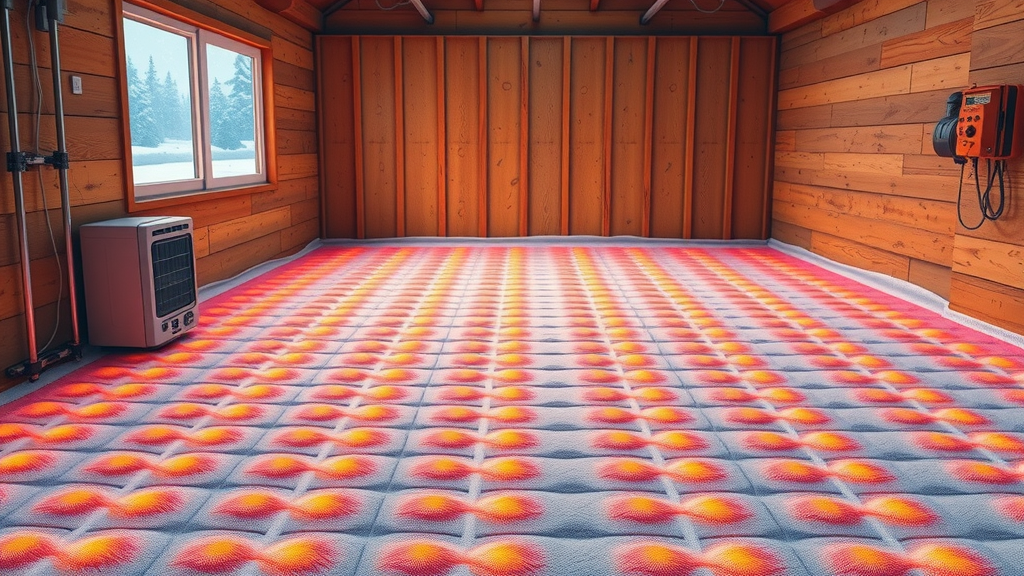
Floor Mats, Drainage, and Accessories for Winter Garage Floor Maintenance
Combining the right floor mats, drain systems, and accessories is the backbone of a robust winter garage floor maintenance routine. These tools help manage melted snow, protect coated floors, and create a safer, longer-lasting environment for vehicles and storage. Below are solutions to optimize surface protection as temperatures drop.
Best Garage Floor Mats for Winter Protection
When it comes to winterizing your garage floors, absorbent floor mats are essential. Heavy-duty containment mats with raised edges trap water, mud, and dirt, keeping puddles off the main floor surface. Choose mats that are oil- and chemical-resistant, easy to roll up and wash, and sized for key traffic areas like under vehicles and at doorways. Layering mats over an epoxy or polyaspartic floor coating gives you the ultimate line of defense against winter’s harshest weather.
Also, consider interlocking floor tiles for added insulation and shock absorption—ideal if you use your garage for more than parking. By combining mats and tiles, you’ll protect your garage floor from both top-down moisture and damage from below.
Ensuring Proper Drainage to Protect Your Garage Floor
Adequate drainage is key to effective winter garage floor maintenance. Water that’s allowed to pool on your floor creates slip hazards and can seep through coatings, undermining your efforts to protect your garage. Installing a floor drain (or at least grading your garage floor to slope gently toward an exit) helps direct melted snow and rainwater away from problem areas.
Pair your improved drainage with squeegees and wet/dry vacuums for fast water removal. Remember: even the best concrete coating is compromised when deep standing water finds its way through expansion joints or cracks.
Must-Have Accessories for Winter Garage Floor Maintenance
- Edge containment mats
- Wet/dry vacuums
- Non-slip epoxy or polyaspartic floor coatings
In addition to robust floor coatings and floor mats, equip your winter garage with edge containment mats for high-traffic zones, a reliable wet/dry vacuum for water emergencies, and, if possible, a modern, non-slip epoxy coating for extra traction. These accessories help prevent puddling, slips, and premature wear—protecting your investment for many winters to come.
Winter Garage Floor Maintenance Schedule & Key Reminders
| Task | Frequency | Best Practices |
|---|---|---|
| 2-3x per week | Focus on entry areas | |
| Floor Washing | 1x per week | Use mild, non-corrosive cleaners |
| Inspect for Damage | Bi-weekly | Check for cracks/surface wear |
| Apply Salt/Tire Mats | Monthly | Cover high traffic zones |
Building consistency into your routine maintenance not only simplifies winter garage floor maintenance but also ensures your garage stays in peak condition year-round. Follow this schedule strictly for best results, and don’t hesitate to increase cleaning frequency during times of heavy snow, rain, or high vehicle traffic.
Watch: Winter Garage Floor Maintenance Routine
Step-by-step demonstration of cleaning, sealing, and mat placement in a modern garage. Includes close-up shots of techniques and products with expert voiceover. (1080p HD Quality)
People Also Ask: Winter Garage Floor Maintenance
How to keep your garage floor clean in the winter?
To keep your garage floor clean during winter, sweep away dirt and road salt daily, lay down absorbent mats by every entry point, and wash with a pH-neutral cleaner weekly. Rapidly remove puddled water using squeegees or wet/dry vacuums to inhibit stains, salt residue, and mold. Regular maintenance of your garage floor prevents long-term damage and ensures safety for the whole family.
How to dry out a garage floor in winter?
Drying out your garage floor in winter is all about maximizing airflow and moisture control. Place portable fans or adjust vents to boost circulation, and use a dehumidifier for stubborn dampness. Installing heated mats at entry points will evaporate snow and ice quickly, keeping your floor surface consistently dry, slip-free, and protected from freeze-thaw damage.
Can you seal a garage floor in the winter?
Yes, you can seal a garage floor in winter using polyaspartic or specially formulated cold-temperature epoxy coatings. Ensure the floor is clean and bone dry before application, and schedule projects during dry spells with above-freezing temperatures. This approach preserves the integrity of your garage floor and extends the life of your surface coating.
How to keep concrete garage floor warm in winter?
Keep concrete garage floors warm in winter by installing insulated mats, applying a specialized concrete coating designed for thermal insulation, and supplementing with portable space heaters or radiant heating panels. Together, these methods help retain comfort, prevent freezing hazards, and make winter garage living more enjoyable.
FAQs: Winter Garage Floor Maintenance
- What is the best mop or cleaner for garage floors in winter? Use microfiber or rubber-blade mops paired with a non-corrosive, pH-neutral floor cleaner to eliminate dirt and salt without damaging floor coatings.
- Do concrete coatings reduce winter slip hazards? Yes, a well-applied epoxy or polyaspartic floor coating adds crucial slip resistance, especially when paired with mats in high-traffic areas.
- When is it too cold to apply a new floor coating? Most coatings require temperatures above 40°F, but polyaspartic formulations can go as low as 32°F. Always follow product guidelines for best results.
- Should I repair cracks in my garage floor in winter or wait until spring? Small cracks should be patched immediately to prevent freeze-thaw expansion. Larger repairs can wait for warmer weather if necessary.
Key Takeaways: Protect Your Garage Floor This Winter
- Winter garage floor maintenance prevents long-term damage and costly repairs.
- Modern coatings (epoxy, polyaspartic) offer effective cold-weather protection.
- Floor mats and proper drainage are essential for salt and moisture management.
Conclusion: Ensure Your Garage with Regular Winter Garage Floor Maintenance
"Your garage floor is the foundation of your workspace—preserve it through diligent winter care." – Home Maintenance Pro
Regular maintenance is the most effective way to protect your garage floor during winter—start today to safeguard your investment.
Get Professional Help: Winter Garage Floor Maintenance Services
If you want the absolute best results for winter garage floor maintenance—from coating application to drainage planning—consider hiring a professional. Experts ensure your floor enjoys maximum protection and a flawless finish, even during the harshest winter months.
Call Us now to get your FREE Quote! 800-280-9210
To enhance your understanding of winter garage floor maintenance, consider exploring the following resources:
-
“TLC for Garage Floors” (thisoldhouse.com) offers comprehensive guidance on addressing common garage floor issues, including methods for removing oil stains, eliminating rust spots, and repairing cracks and chips.
-
“How To Maintain Your Garage Floors In the Winter” (wetreadwell.com) provides practical advice on installing walk-off mats to capture excess salt and moisture, as well as recommendations for cleaning solutions to keep your garage floor in optimal condition during the colder months.
By consulting these resources, you’ll gain valuable insights and actionable tips to effectively protect and maintain your garage floor throughout the winter season.
 Add Row
Add Row  Add
Add 

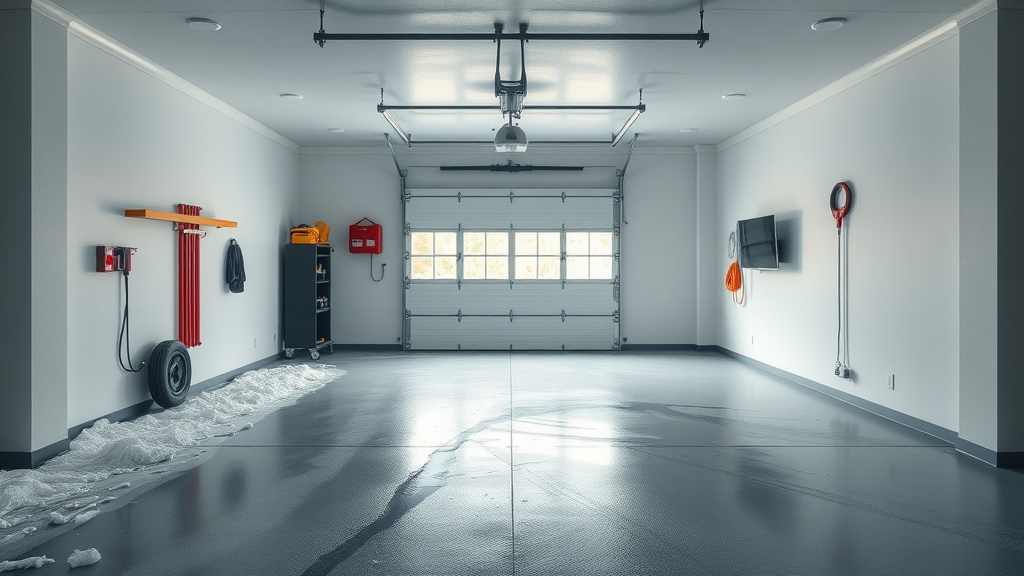

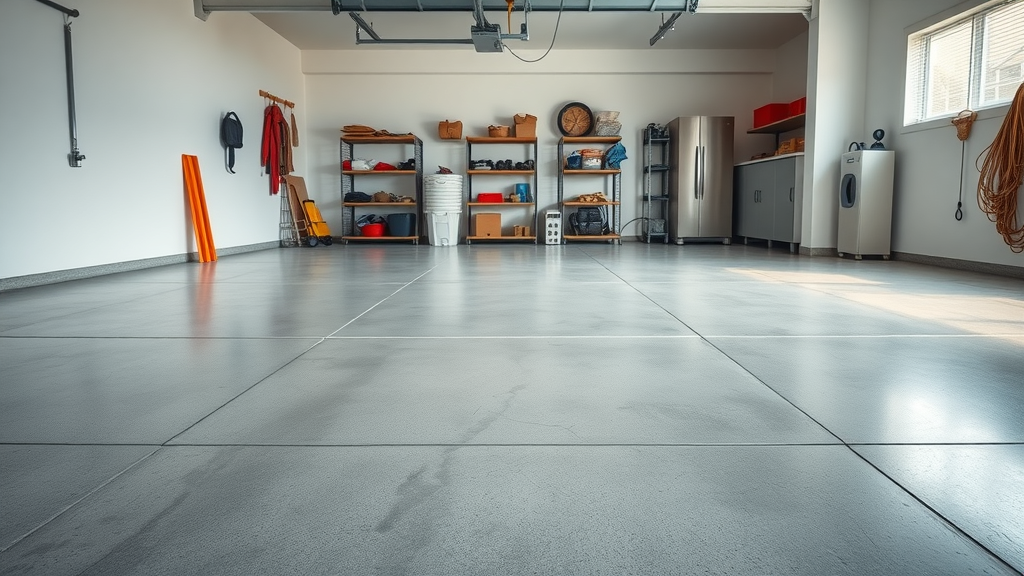
Write A Comment